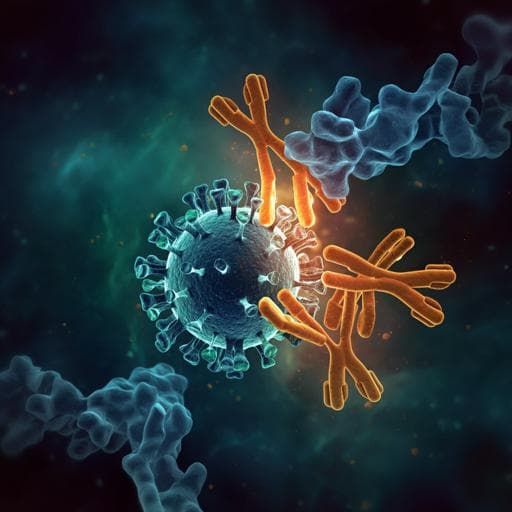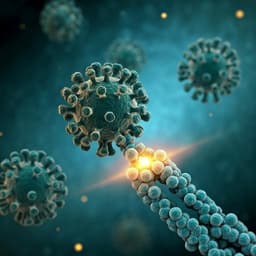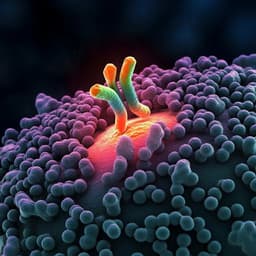
Medicine and Health
Human antibodies to SARS-CoV-2 with a recurring YYDRXG motif retain binding and neutralization to variants of concern including Omicron
H. Liu, C. I. Kaku, et al.
Discover how researchers Hejun Liu, Chengzi I. Kaku, Ge Song, Meng Yuan, Raiees Andrabi, Dennis R. Burton, Laura M. Walker, and Ian A. Wilson have identified a unique antibody response to SARS-CoV-2, unveiling a common motif that could lead to powerful vaccines against various sarbecoviruses, including the Omicron variant.
~3 min • Beginner • English
Introduction
The COVID-19 pandemic continues despite effective vaccines, with viral evolution (antigenic drift) reducing vaccine and antibody efficacy. Many potent neutralizing antibodies target the spike RBD but are vulnerable to mutations at the receptor-binding site in variants such as Beta, Delta, and Omicron. Broadly neutralizing antibodies (bnAbs) exist that target conserved regions (e.g., CR3022 site, N343 glycan site, S2), but are rare. The study asks whether common, convergent solutions exist in the human antibody response that enable broad recognition of SARS-CoV-2 variants and other sarbecoviruses. The authors identify a recurrent CDR H3 YYDRxG motif, encoded by IGHD3-22, shared between cross-neutralizing antibodies ADI-62113 and COVA1-16 that target a conserved RBD epitope. They hypothesize that this motif enables broad neutralization, including against Omicron, and can be used to discover bnAbs and guide vaccine/therapeutic design.
Literature Review
Prior studies have shown that many potent neutralizing antibodies focus on the RBS of spike but often lose activity against variants (e.g., Beta, Delta, Omicron). Broadly cross-neutralizing antibodies, though rarer, target conserved RBD surfaces such as the CR3022 epitope and the N343 glycan site, and regions in S2. Structural characterizations (e.g., CR3022, COVA1-16) revealed conserved epitopes that can confer breadth across sarbecoviruses. Deep mutational scanning indicates residues like F377, K378, and S383 are critical for RBD stability and rarely mutate in circulating variants, supporting these sites as targets for breadth. An antibody class with a YYDRSGY motif (e.g., 10-40) targeting the CR3022 site has been described as part of a larger family of motif-sharing bnAbs. Collectively, prior work motivates searching for recurring sequence motifs (e.g., YYD-containing CDR H3s) associated with broad sarbecovirus neutralization.
Methodology
- Antibody and antigen production: ADI-62113 IgG produced in Saccharomyces cerevisiae and purified by protein A chromatography; Fab generated by papain digestion and purified. Additional YYDRxG antibodies and EUA antibodies produced similarly. MOD8_P2_IgG_B11-P1369 and PZF12_P2_IgG_F7-P1369 were expressed in ExpiCHO cells and purified.
- RBD production for crystallography: SARS-CoV-2 RBD (residues 333–529) expressed in insect cells using baculovirus (Sf9/High Five), purified by Ni-NTA and SEC.
- Structural studies: ADI-62113 Fab complexed with SARS-CoV-2 RBD; crystals grown by sitting-drop vapor diffusion; X-ray diffraction collected at SSRL 12-1; data processed with HKL2000; structure solved by molecular replacement (PHASER) and refined (COOT/PHENIX). Interface analyses by PISA.
- Computational motif search: Compiled >205,000 public human antibody sequences (GenBank and prior publications). CDR H3s annotated (PyIR/IgBLAST). Pattern search for YYDRxG and homologous sequences with length constraints: at least 5 N-terminal and 7 C-terminal residues flanking the hexapeptide (overall CDR H3 ≥18 aa), derived from structural positioning. Gene usage analyzed; literature curated for function/neutralization.
- Conservation analysis: 169 sarbecovirus RBD sequences aligned (MUSCLE/EBI), surface conservation mapped (ConSurf) and visualized (PyMOL).
- Binding breadth by yeast surface display: 17 sarbecovirus RBDs displayed on yeast (EBY100) for binding titrations with IgGs and hACE2; flow cytometry readouts; KD,APP calculated from 4-parameter fits.
- Binding to VoC RBDs by ELISA: WT, Beta, Delta, and Omicron RBDs coated on plates; serial antibody dilutions; detection with HRP anti-human IgG; absorbance at 450 nm.
- Pseudovirus neutralization: MLV-based pseudoviruses bearing spikes of SARS-CoV-2 WT and VoCs (Alpha, Beta, Gamma, Delta, Omicron) and SARS-CoV produced in HEK293T; HeLa-hACE2 target cells; serial antibody dilutions; luciferase readout; IC50 calculated by 4-parameter logistic fits; ≥2 biological replicates.
- Statistics: Non-parametric Kruskal–Wallis for group comparisons (e.g., motif frequency by cohort); significance P>0.05 considered not significant for that analysis.
Key Findings
- ADI-62113 breadth and epitope:
- Binds with high affinity to a broad range of sarbecovirus RBDs, including ACE2-utilizing (clades 1a/1b) and non-ACE2-utilizing (clades 2/3) viruses by yeast display.
- Crystal structure (2.6 Å) shows binding to the highly conserved CR3022 site with an approach angle that sterically interferes with ACE2 binding, explaining high potency.
- CDR H3 dominates the RBD interface (~69% of total RBD buried surface area), engaging conserved residues (e.g., F377, K378, Y369, S371, S383, Q414, D427, F429, G413). Interactions include hydrogen bonds, hydrophobic, and amide–π contacts.
- Recurring YYDRxG motif and structural basis:
- Comparative structures of ADI-62113 and COVA1-16 reveal a shared CDR H3 YYDRxG hexapeptide (positions around VH 99–100d) forming a conserved local structure.
- A type I β-turn followed by a G1 β-bulge (requiring glycine at VH G100d) shifts the β-hairpin register and stabilizes the motif; VH G100d carbonyl hydrogen-bonds to RBD S383; structural constraints favor glycine due to tight spacing near RBD residues 382–386.
- Motif prevalence from computational search:
- From >205,000 antibody sequences, 153 heavy chains contained a YYDRxG-like motif with length constraints; 88.2% used IGHD3-22 overall.
- 100 antibodies were anti-SARS-CoV-2; all 100 used IGHD3-22 for the D region; diverse IGHV/IGHJ usage without strict constraints (e.g., IGHV3-30, IGHV4-39, IGHV3-33, IGHV1-69 enriched).
- YYDRxG requires IGHD3-22 reading frame 2; other RFs encode a stop or different sequence. Somatic hypermutation commonly converts germline serine to arginine at the motif’s R position.
- Neutralization and cross-neutralization:
- Of 28 YYDRxG antibodies with neutralization data, 79% neutralized SARS-CoV-2. Among 22 neutralizers, 36% cross-neutralized SARS-CoV; 50% not determined for SARS-CoV.
- Many YYDRxG antibodies retain binding to VoC RBDs (Beta, Delta, Omicron), whereas most EUA antibodies lost binding, especially to Omicron. Example fold-reduction in affinity to VoCs (relative to WT): ADI-62113 Beta 2.8×, Delta 1.7×, Omicron 8.9×; several EUAs showed >100× losses to Omicron.
- Neutralization of representative sequence-identified antibodies: MOD8_P2_IgG_B11-P1369 IC50s (µg/mL): Alpha 0.15, Beta 0.11, Gamma 0.10, Delta 0.16, Omicron 0.28, SARS-CoV >10; PZF12_P2_IgG_F7-P1369: Alpha 0.37, Beta 0.26, Gamma 1.06, Delta 0.28, Omicron 1.14, SARS-CoV >50.
- Cohort occurrence and biomarker potential:
- YYDRxG antibodies were identified in 32 donors across infected, vaccinated, and infected-then-vaccinated cohorts, though in low serum abundance; presence correlates with breadth and could serve as a biomarker of broad neutralization.
- Overall implication: YYDRxG motif in CDR H3, encoded by IGHD3-22 with specific structural features, represents a convergent human solution for targeting a conserved sarbecovirus RBD epitope, conferring breadth to SARS-CoV-2 variants including Omicron and to SARS-CoV.
Discussion
The study addresses whether recurring sequence-structural solutions exist that enable broad sarbecovirus neutralization by human antibodies. Structural analyses showed that the YYDRxG motif in CDR H3, stabilized by a β-bulge, positions key residues for optimal engagement of a highly conserved CR3022-site epitope on the RBD. This epitope’s conservation, functional importance, and limited mutational tolerance underpin the observed breadth across SARS-CoV-2 VoCs (including Omicron) and other sarbecoviruses. The computational survey confirms that YYDRxG is a recurrent, IGHD3-22–encoded solution present in numerous COVID-19 and vaccinee-derived antibodies. Functionally, most motif-bearing antibodies tested neutralize SARS-CoV-2 and a subset cross-neutralizes SARS-CoV, with retention of binding to VoCs where many clinical antibodies fail. The findings suggest that sequence-based identification of YYDRxG-containing antibodies can enrich for bnAbs, informing therapeutic discovery and focusing vaccine design toward eliciting such motifs to achieve pan-sarbecovirus breadth.
Conclusion
This work identifies and structurally rationalizes a recurring CDR H3 YYDRxG motif, encoded by IGHD3-22 in reading frame 2, as a convergent feature of human antibodies targeting a conserved RBD epitope. Antibodies with this motif, exemplified by ADI-62113 and COVA1-16, retain binding/neutralization against SARS-CoV-2 variants including Omicron and show cross-neutralization to SARS-CoV. A large-scale sequence search uncovered many such antibodies in infected and vaccinated individuals, supporting the motif’s generality. These insights enable sequence-based discovery of bnAbs and advocate for vaccine strategies that focus responses toward IGHD3-22–encoded YYDRxG-bearing antibodies to achieve broad sarbecovirus protection. Future work should expand functional testing of motif-bearing antibodies, define optimal heavy/light gene pairings and CDR H3 lengths for potency, and assess in vivo protection against diverse sarbecoviruses and evolving Omicron lineages.
Limitations
- Sample size for functionally characterized YYDRxG antibodies is limited (n≈28 with neutralization data), restricting statistical power to infer IGHV/IGL pairing preferences and general potency rules.
- Many motif-bearing antibodies identified by sequence were not functionally tested; presence of the motif alone may be insufficient without adequate affinity or proper chain pairing.
- Neutralization assays used pseudoviruses and in vitro systems; in vivo efficacy across diverse sarbecoviruses and emerging subvariants was not comprehensively evaluated.
- Analyses primarily focused on Omicron BA.1; breadth against later Omicron sublineages and future variants was not assessed.
- Low serum abundance of YYDRxG antibodies suggests challenges for vaccine elicitation and detection as a biomarker without targeted immunogen designs.
Related Publications
Explore these studies to deepen your understanding of the subject.







